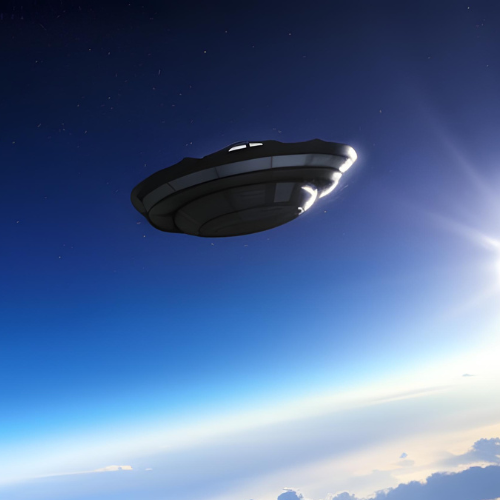Howard A. Doughty
Sightings of allegedly extraterrestrial vehicles wax and wane for as yet unexplained reasons. A large number were reported in the years following World War II — perhaps in an effort to transfer anxieties away from real horrors in the wake of the most hideous human conflict in history. Another spate of sightings, perhaps in reaction to the political peculiarities of the past decade in the United States, is now being reported. Evidence of sporadic increases in alien reconnaissance? Unlikely.
It seems, however, that American intelligence and military authorities are paying more than their usual attention, whatever the motivation. In fact, this summer the U.S. House of Representatives, in a rare moment of bipartisanship, will be diving into the records in order to “finally get to the truth” (or temporarily distract a fractious public from the political tensions of the day). Whatever the cultural dynamics, the topic is not new.
From Madame Blavatsky and Sir Arthur Conan Doyle in seances to charlatan spoon-benders on Las Vegas stages, and from the exploits of Buck Rogers to the power of “the Force,” weird stuff happens… or seems to. There are, however, differences among spiritualism, telekinetics, tarot cards, faith healers, and aliens — whether benign like E.T., or hideous like Sigourney Weaver’s fellow-travelling extraterrestrial. Whether dubbed mystical, occult, paranormal, or miraculous on the one hand, or entertaining magic tricks on the other, all pose questions for scientists and skeptics.
Most such matters can quickly be debunked. Exposing pseudoscience and psychological chicanery is pretty easy for folk with a penchant for actual evidence. The main problem for people confronting displays that demand suspensions of disbelief is the temptation to turn dispassionate critical inquiry into a string of expletives as they witness the “idiocy, fabrications and lies” of those who peddle claims for “ancient aliens” and such.
In the spirit of open inquiry, we must not immediately succumb to emotions. Serious issues are at stake. They include the question of whether we are alone as sentient lifeforms in the vast and expanding universe. More immediately, is our demand for what we consider scientific credibility merely evidence of our own petty intellectual provincialism?
There are, depending on which “educated guess” we accept, somewhere near 700 quintillion planets in the universe. This is impossible to truly imagine, because 7 quintillion is a 7 followed by 18 zeros, leaving us to consider a number of planets that starts with a 7 and ends not with 18 but with 20 zeros. I’m not a betting man, but I’d wager that our planet is not entirely unique in having somewhere between 7.5 and 10 million animal species (never mind all those that have gone extinct since the Cambrian explosion some 500 million years ago, many with recognizable brains and some with rudimentary self-consciousness).
We should also not assume that our science is as comprehensive and definitive as we might wish. We should not demonstrate the conceit of the rampantly racist French historian, Ernest Renan, who, in the 1850s, confidently predicted that modern science would discover all the important laws of nature by the end of his century, leaving only the details to be filled in. After all, in the last 100 years or so, we have added essential understanding about our knowledge of the physical sciences in the way of the theory of relativity, quantum theory, the “Big Bang,” as well as every astonishing discovery in biology. To boast that we have exhausted all possibilities for future scientific revolutions is evidence only of cultural naiveté.
And, let’s be frank. UFOs or UAPs (either “unidentified aerial phenomena” or “unidentified anomalous phenomena” as they are more fashionably known today) do exist! They are “objects” or “phenomena.” They are “unidentified,” which means we don’t know what they are… yet. They may be perfectly normal things like errant weather balloons. They may be explainable optical illusions like high-flying kites or peculiar weather formations. Or they may simply be the product of bad data. Mainly because they might pose a threat to commercial air traffic, they are a matter of ongoing interest to the authorities which continue to monitor reported observations, especially from pilots of military aircraft.
No doubt official reports from the so-called “deep state” will leave “true believers” unimpressed; however, genuine scientific skeptics will maintain open minds without the disqualifying addition of empty heads. We will, then, continue to trust Han Solo to pilot space vehicles in George Lucas fantasies, but we may be forgiven if we decline invitations from Harrison Ford to take a spin in a vintage airplane.


Addendum:
for a rather jolly summary of why aliens may exist but almost certainly have not visited Earth (spoiler alert: if they had, we’d all be dead), you might be informed and amused by taking a half-hour to watch this video from Ryan McBeth that popped up in my inbox a few hours ago):
https://www.youtube.com/watch?v=vlQYnp9L9uE
I saw an UFO in the etymological sense as a teenager – it was quite the bizarre experience, seeing something up there that one could not understand. But precisely because I did not immediately understand it, I had learned enough (primarily from my father, a chemist) to *think about it*. I conclude – with no way to ever know – that I saw the rare occurrence of a meteor, *in daylight*. I forget now what year that was; it was visible from our part of greater Montreal and looked momentarily like an aircraft (with contrail) suddenly and briefly plunging downward, but since it was so far off, it was just a point of light. Notice how easy it is to move from description to unwarranted description – I just did it myself! (The “aircraft” came to me spontaneously as I was trying to describe the “tail”.)